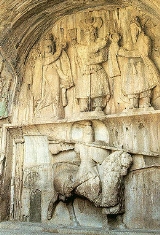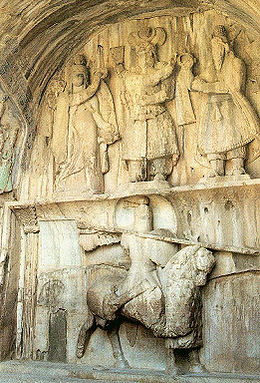
Savaran cavalry
Encyclopedia
The Savārān cavalry were Persian military units and were a division of cavalry during the time of the Sassanid Persian dynasty; they ranged from light cavalry such as horse archers to heavy cavalry such as Cataphract
s. Each Savārān unit would have had its own Drafsh (banner). Membership in such units and other important posts was generally reserved for individuals of Aryan ancestry.The Savaran were led by Savārān Sardār.
 The Savārān Sardār were high ranking officers who were in charge of the Savārān cavalry, their position was so high up in Sassanid society that they were only answerable to the Eran-Spahbad (Commander in Chief) and the Shahanshah himself. They would be guarded heavily by Cataphract
The Savārān Sardār were high ranking officers who were in charge of the Savārān cavalry, their position was so high up in Sassanid society that they were only answerable to the Eran-Spahbad (Commander in Chief) and the Shahanshah himself. They would be guarded heavily by Cataphract
style cavarly. The post of Savaran Sardar was held by a member of the Mihran-Pahlav family.
Parts of the Savārān division were high ranking including the Pushtigban Body Guards
a super heavy shock cavalry these were the royal guards of the Shah himself. The influential Savārān cavalry were mostly made up of heavily armoured cavalry. Generally of which the cavalry were aristocracy or even from the imperial family themselves. There were also commander of which were Elite as well. These parts of the Savārān regiments were kept as reserves.
with long sleeves and chaps
covered in scale armor or, less often, plated mail
. Their helmets, of the Spangenhelm
type, would have been adapted throughout the Sassanid Persian period. Also horses would probably have had armored chests and heads, consisting of an apron
and headpiece
, or total body protection consisting of five separate pieces that cover the whole body, made from either boiled leather
or scale armor. Some Savārān units such as mercenaries (Kushans, Indians, Huns) may have worn little to no armor at all, allowing them to be rather more swift, silent and mobile.
helmets worn by members of the Savārān units in battle would have evolved through the centuries. During the 3rd-6th-century era of the Sassanian empire, the Spangenhelm would have probably been made of felt and hardened leather. However, by the late 6th/early-7th century they would have been decorated with flowers and purple ball with mail and small areas through which to breath and see.
as their banner.
Cataphract
A cataphract was a form of armored heavy cavalry utilised in ancient warfare by a number of peoples in Western Eurasia and the Eurasian Steppe....
s. Each Savārān unit would have had its own Drafsh (banner). Membership in such units and other important posts was generally reserved for individuals of Aryan ancestry.The Savaran were led by Savārān Sardār.
Elite Savārān

Cataphract
A cataphract was a form of armored heavy cavalry utilised in ancient warfare by a number of peoples in Western Eurasia and the Eurasian Steppe....
style cavarly. The post of Savaran Sardar was held by a member of the Mihran-Pahlav family.
Parts of the Savārān division were high ranking including the Pushtigban Body Guards
Pushtigban Body Guards
The Pushtigban Body Guard was an elite Persian military unit during the time of the Sassanid Persian dynasty, charged with the protection of the Emperor....
a super heavy shock cavalry these were the royal guards of the Shah himself. The influential Savārān cavalry were mostly made up of heavily armoured cavalry. Generally of which the cavalry were aristocracy or even from the imperial family themselves. There were also commander of which were Elite as well. These parts of the Savārān regiments were kept as reserves.
Armor
The Savārān cavalry during this early period had much in common with their Parthian (Arsacid) predecessors, most of whom would have worn a scale armor cuirassCuirass
A cuirass is a piece of armour, formed of a single or multiple pieces of metal or other rigid material, which covers the front of the torso...
with long sleeves and chaps
Chaps
Chaps are sturdy coverings for the legs consisting of leggings and a belt. They are buckled on over trousers with the chaps' integrated belt, but unlike trousers they have no seat and are not joined at the crotch. They are designed to provide protection for the legs and are usually made of leather...
covered in scale armor or, less often, plated mail
Plated mail
Plated mail is a type of mail with embedded plates. Armour of this type has been used in the Middle East, Japan, China, Korea, Central Asia, Greater Iran, India, Eastern Europe, and by the Moors.-Types of plated mail:In Russia there are three known varieties of this armour...
. Their helmets, of the Spangenhelm
Spangenhelm
The Spangenhelm was a popular European war combat helmet design of the Early Middle Ages. The name is of German origin. Spangen refers to the metal strips that form the framework for the helmet and could be translated as clips, and -helm simply means helmet. The strips connect three to six steel or...
type, would have been adapted throughout the Sassanid Persian period. Also horses would probably have had armored chests and heads, consisting of an apron
Apron
An apron is an outer protective garment that covers primarily the front of the body. It may be worn for hygienic reasons as well as in order to protect clothes from wear and tear. The apron is commonly part of the uniform of several work categories, including waitresses, nurses, and domestic...
and headpiece
Headpiece
Headpiece can refer to:*A typically thin metallic crown, headband, or tiara worn around the forehead. Commonly worn by ancient rulers, such as Cleopatra, headpieces usually carry some emblem of religious or political significance....
, or total body protection consisting of five separate pieces that cover the whole body, made from either boiled leather
Boiled leather
Boiled leather, sometimes called cuir bouilli, was a historical construction material for armour. It consists of thick leather, boiled in water . The boiling causes the leather to be harder but more brittle...
or scale armor. Some Savārān units such as mercenaries (Kushans, Indians, Huns) may have worn little to no armor at all, allowing them to be rather more swift, silent and mobile.
Spangenhelm
The SpangenhelmSpangenhelm
The Spangenhelm was a popular European war combat helmet design of the Early Middle Ages. The name is of German origin. Spangen refers to the metal strips that form the framework for the helmet and could be translated as clips, and -helm simply means helmet. The strips connect three to six steel or...
helmets worn by members of the Savārān units in battle would have evolved through the centuries. During the 3rd-6th-century era of the Sassanian empire, the Spangenhelm would have probably been made of felt and hardened leather. However, by the late 6th/early-7th century they would have been decorated with flowers and purple ball with mail and small areas through which to breath and see.
Weaponry
The Savārān cavalry were armed with a variety of weapons. The traditional heavy cavalry weapons, such as maces, lances, and swords would have been used, as well as a variety of other weapons, such as axes. Savārān cavalry were not, however restricted to short-range weapons, as they often carried weapons such as darts and bows.Drafsh
Each Savārān unit would have a Drafsh. These would have often included mythological creatures and animals.These animals would have included:Pil(Elephants), asp(Horse), xirs(Bears), Shaigr(Lions), Ahug(Deers), these would also include Zoroastrian mythological creatures such as Bashkuch and the army of Savārān would have the Derafsh KavianiDerafsh Kaviani
The Derafsh Kaviani , was the legendary royal standard of the Sassanid kings. The banner was also sometimes called the "standard of Jamshid" , the "standard of Fereydun" , and the "royal standard" .-Name:The name Drafš e Kāvīān The Derafsh Kaviani (Middle Persian: Drafš e Kāvīān), was the...
as their banner.
See also
- CataphractCataphractA cataphract was a form of armored heavy cavalry utilised in ancient warfare by a number of peoples in Western Eurasia and the Eurasian Steppe....
- ClibanariiClibanariiThe Clibanarii or Klibanophoroi were a Sassanid Persian, late Roman and Byzantine military unit of heavy armored horsemen. Similar to the cataphracti, the horsemen themselves and their horses were fully armoured...
- Sassanid armySassanid armyThe birth of the Sassanid army dates back to the rise of Ardashir I , the founder of the Sassanid dynasty, to the throne. Ardashir aimed at the revival of the Persian Empire, and to further this aim, he reformed the military by forming a standing army which was under his personal command and whose...
- SpahbodSpahbodSpahbod or Spahbed , is derived from the words Spah and bod ; or "Aspah'Paeity" , and means commander of cavaliers/ knights; alternatively Spah Salar was a rank used in the Parthian empire and more widely in the Sassanid Empire of Persia...
- Byzantine armyByzantine armyThe Byzantine army was the primary military body of the Byzantine armed forces, serving alongside the Byzantine navy. A direct descendant of the Roman army, the Byzantine army maintained a similar level of discipline, strategic prowess and organization...
- Late Roman armyLate Roman armyThe Late Roman army is the term used to denote the military forces of the Roman Empire from the accession of Emperor Diocletian in 284 until the Empire's definitive division into Eastern and Western halves in 395. A few decades afterwards, the Western army disintegrated as the Western empire...
- Roman-Persian WarsRoman-Persian WarsThe Roman–Persian Wars were a series of conflicts between states of the Greco-Roman world and two successive Iranic empires: the Parthian and the Sassanid. Contact between the Parthian Empire and the Roman Republic began in 92 BC; wars began under the late Republic, and continued...
- DerbentDerbentDerbent |Lak]]: Чурул, Churul; Persian: دربند; Judæo-Tat: דארבּאנד/Дэрбэнд/Dərbənd) is a city in the Republic of Dagestan, Russia, close to the Azerbaijani border. It is the southernmost city in Russia, and it is the second most important city of Dagestan...
, the only surviving Sassanid fortress - Persian war elephantsPersian war elephantsPersians used war elephants at the Battle of Gaugamela in 331 BC. The battle raged between king Alexander the Great of Macedon and king Darius III of Persia...
External links
- http://books.google.com/books?id=aQspOf291_cC&pg=PA3&dq=sassanid+elite+cavalry+Sav%C4%81r%C4%81n
- http://www.iranchamber.com/history/sassanids/sassanian_army.php
- http://books.google.com/books?q=Sav%C4%81r%C4%81n
- http://books.google.com/books?id=qNxLidZpVjgC&pg=PA258&dq=savaran+cavalry&hl=en&ei=67-cTIGYBsOfngeR4eirDQ&sa=X&oi=book_result&ct=result&resnum=3&ved=0CDMQ6AEwAg#v=onepage&q=savaran%20cavalry&f=false

